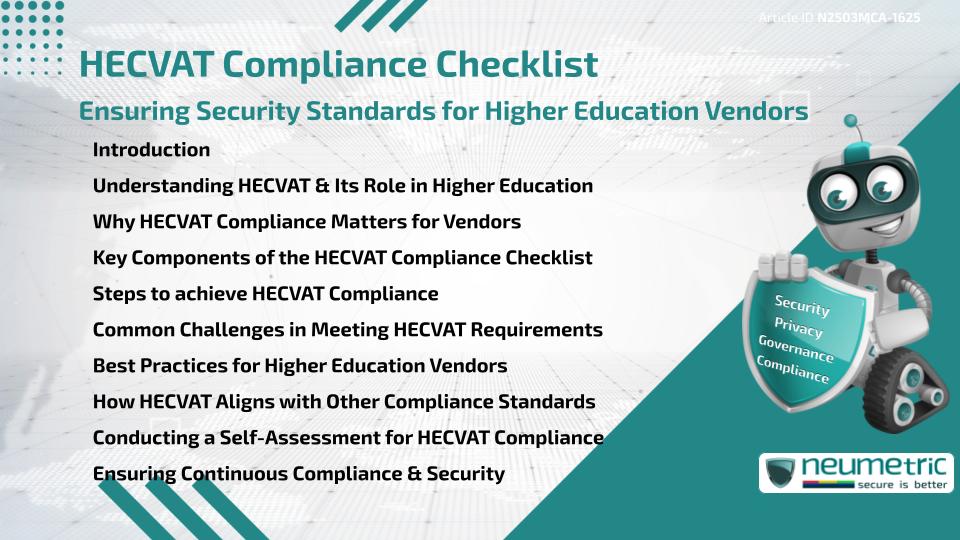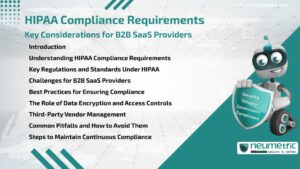Table of Contents
ToggleIntroduction
As higher education institutions increasingly rely on Third Party vendors for cloud services & software solutions, security Risks have become a critical concern. The Higher Education Community Vendor Assessment Tool [HECVAT] helps institutions evaluate vendor Security Controls & ensure Data Protection. This article provides a comprehensive HECVAT Compliance checklist, guiding vendors on meeting security requirements & streamlining the assessment process.
Understanding HECVAT & Its Role in Higher Education
HECVAT is a standardised questionnaire developed by the higher education community to assess vendor security practices. It helps institutions determine whether a vendor’s services meet their security & Compliance Requirements, reducing risks associated with data breaches, unauthorized access & regulatory non-compliance.
Why HECVAT Compliance Matters for Vendors
For vendors serving higher education, achieving HECVAT Compliance is crucial for establishing trust & securing contracts. Many universities & colleges require vendors to complete HECVAT before engaging in partnerships. Compliance demonstrates a vendor’s commitment to Data Security, Privacy & regulatory adherence.
Key Components of the HECVAT Compliance Checklist
- Data Protection Measures: Vendors must outline encryption practices, data storage Policies & Access Controls.
- Network Security: Firewalls, intrusion detection systems & Security Monitoring processes should be in place.
- User Access Management: Role-based Access Control [RBAC], multi-factor authentication [MFA], and least privilege principles are essential.
- Incident Response Plan: Vendors must define their approach to breach detection, reporting & mitigation.
- Regulatory Compliance: Vendors should align with Compliance standards such as General Data Protection Regulation [GDPR], Family Educational Rights & Privacy Act [FERPA], and National Institute of Standards & Technology [NIST] guidelines.
- Disaster Recovery & Business Continuity: Clear Policies for data backups & system restoration ensure operational resilience.
Steps to achieve HECVAT Compliance
- Understand HECVAT Requirements: Review the HECVAT questionnaire & ensure alignment with its security expectations.
- Perform a Security Audit: Conduct an Internal Audit to assess gaps & address Vulnerabilities.
- Implement Security Controls: Strengthen Security Policies, encryption & access management.
- Complete the HECVAT Questionnaire: Provide clear, accurate responses supported by documented Security Policies.
- Engage in Continuous Monitoring: Regularly update Security Measures & respond to evolving Threats.
Common Challenges in Meeting HECVAT Requirements
- Complex Documentation: Providing comprehensive yet concise security documentation can be challenging.
- Evolving Security Threats: Vendors must continuously update controls to address emerging Risks.
- Resource Constraints: Smaller vendors may struggle with the costs & expertise needed for Compliance.
- Integration with Existing Standards: Aligning HECVAT with existing Compliance frameworks requires additional effort.
Best Practices for Higher Education Vendors
- Maintain Transparency: Clearly communicate Security Policies & Risk Management strategies.
- Automate Compliance Processes: Utilize security tools to streamline documentation & assessments.
- Engage Third Party Audits: External evaluations help validate security practices.
- Stay Updated on Industry Trends: Monitor changes in Compliance Requirements & Security Risks.
How HECVAT Aligns with Other Compliance Standards
HECVAT shares similarities with SOC 2, ISO 27001, NIST & GDPR in assessing security, Privacy & Risk Management. Vendors that already comply with these standards may find it easier to meet HECVAT requirements by mapping their existing controls to the assessment.
Conducting a Self-Assessment for HECVAT Compliance
Performing a self-assessment helps vendors identify Compliance gaps before submitting HECVAT responses. This process includes:
- Reviewing Security Policies & aligning them with HECVAT questions.
- Testing Security Controls for effectiveness.
- Documenting evidence to support Compliance claims.
- Engaging Stakeholders in Compliance discussions.
Ensuring Continuous Compliance & Security
HECVAT Compliance is not a one-time process. Vendors should:
- Regularly update Security Policies & procedures.
- Conduct periodic security training for Employees.
- Monitor Compliance with automated tools.
- Stay informed about new Cybersecurity Threats & Compliance updates.
Conclusion
HECVAT Compliance is essential for vendors looking to work with higher education institutions. By following a structured approach, vendors can align their security practices with HECVAT requirements, ensuring trust & long-term partnerships. Regular assessments, transparent Security Policies & continuous improvements are key to maintaining Compliance & protecting sensitive educational data.
Takeaways
- The HECVAT Compliance checklist is essential for vendors working with higher education institutions.
- Compliance enhances vendor credibility & ensures Data Security.
- Vendors should align HECVAT with other security frameworks to streamline the process.
- Continuous security improvements & assessments are necessary to maintain Compliance.
FAQ
What is the purpose of the HECVAT Compliance checklist?
The HECVAT Compliance checklist helps higher education institutions assess vendor security practices & ensure Data Protection before engaging in partnerships.
Is HECVAT Compliance mandatory for vendors?
While not legally mandatory, many universities & colleges require vendors to complete HECVAT Compliance checklist assessments before contracting their services.
How does HECVAT compare to other security standards?
HECVAT aligns with existing security frameworks like ISO 27001, NIST & SOC 2, making it easier for compliant vendors to meet its requirements.
What are common mistakes vendors make in HECVAT Compliance?
Errors include providing vague responses, lacking documented Security Policies & failing to update Security Controls regularly.
How often should vendors update their HECVAT Compliance status?
Vendors should review & update their HECVAT Compliance checklist responses annually or whenever significant security changes occur.
Can small vendors achieve HECVAT Compliance?
Yes, small vendors can achieve compliance by adopting best security practices, leveraging automation & seeking expert guidance when needed.
What happens if a vendor fails HECVAT Compliance?
Non-Compliance can result in lost business opportunities with higher education institutions & potential reputational damage.
Are there different versions of HECVAT?
Yes, there are multiple versions, including HECVAT Lite & HECVAT Full, designed for different levels of security assessment based on vendor Risk profiles.
Need help?
Neumetric provides organisations the necessary help to achieve their Cybersecurity, Compliance, Governance, Privacy, Certifications & Pentesting goals.
Organisations & Businesses, specifically those which provide SaaS & AI Solutions, usually need a Cybersecurity Partner for meeting & maintaining the ongoing Security & Privacy needs & requirements of their Clients & Customers.
SOC 2, ISO 27001, ISO 42001, NIST, HIPAA, HECVAT, EU GDPR are some of the Frameworks that are served by Fusion – a centralised, automated, AI-enabled SaaS Solution created & managed by Neumetric.
Reach out to us!





